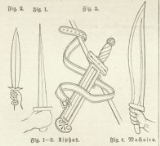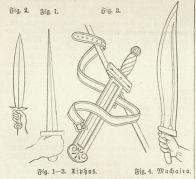
Xiphos
Encyclopedia

Iron Age sword
Swords made of iron appear from the Early Iron Age , but do not become widespread before the 8th century BC....
used by the ancient Greeks. It was a secondary battlefield weapon for the Greek armies after the spear
Spear
A spear is a pole weapon consisting of a shaft, usually of wood, with a pointed head.The head may be simply the sharpened end of the shaft itself, as is the case with bamboo spears, or it may be made of a more durable material fastened to the shaft, such as flint, obsidian, iron, steel or...
or javelin
Pilum
The pilum was a javelin commonly used by the Roman army in ancient times. It was generally about two metres long overall, consisting of an iron shank about 7 mm in diameter and 60 cm long with pyramidal head...
. The classic blade
Blade
A blade is that portion of a tool, weapon, or machine with a cutting edge and/or a pointed tip that is designed to cut and/or puncture, stab, slash, chop, slice, thrust, or scrape animate or inanimate surfaces or materials...
was generally about 50–60 cm long, although the Spartans supposedly started to use blades as short as 30 cm around the era of the Greco-Persian Wars
Greco-Persian Wars
The Greco-Persian Wars were a series of conflicts between the Achaemenid Empire of Persia and city-states of the Hellenic world that started in 499 BC and lasted until 449 BC. The collision between the fractious political world of the Greeks and the enormous empire of the Persians began when Cyrus...
. The Xiphos sometimes has a midrib, or is diamond or lenticular in cross-section. It was generally hung from a baldric
Baldric
A baldric is a belt worn over one shoulder that is typically used to carry a weapon or other implement such as a bugle or drum...
under the left arm. The Xiphos was generally used only when the spear was discarded for close combat. Very few Xiphoi seem to have survived; photos of some of these can be found via the footnotes.
Stone's Glossary
George Cameron Stone
George Cameron Stone was a well-known American arms collector and author as well as an American mining engineer and metallurgist...
has the Xiphos being a name used by Homer for a sword. The entry in the book says that the sword had a double-edged blade widest at about two-thirds of its length from the point, and ending in a very long point. The name Xiphos apparently means something in the way of "penetrating light" according to researcher and swordsmith Peter Johnsson.
The Xiphos' leaf shaped design lent itself to both cutting and thrusting. The design has most likely been in existence since the appearance of the first swords. Blades in bronze and iron are suitable for a leaf shape due to the softness of the metals in comparison to steel. Bronze swords are cast and are thus are more easily formed into a leaf shape than iron swords, which need to be forged (Wrought iron is too soft to make a good sword, but many swords were still made in part or total from wrought iron.).
The early Xiphos was a bronze sword. In the classical period it would have been made of iron. The early Celtic La Tène short sword, contemporary with the Xiphos, had a virtually identical blade design as the Xiphos.
The leaf-shaped short swords were not limited to Greece, as mentioned, but can be found throughout Europe in the late Bronze Age under various names. Bronze leaf-shaped swords from as early as the late second millennium still survive. The Urnfield culture, is associated with the use of the leaf shaped bronze short sword. It is generally thought that iron swords had replaced bronze swords by the early La Tène culture ~500BC. During the Halstatt culture a mixture of bronze and iron swords seem to have existed side by side. Iron tends to become severely oxidized (rusted) over the years, and few iron swords have survived, in contrast to bronze and bronze swords that age very well. Thus, much is known regarding the sword during the Bronze Age but less so in the early Iron Age. Bronze thrusting swords from the second millennium still exist in excellent condition.
The Mycenaean form of the word is attested in the dual, as ' onMouseout='HidePop("91410")' href="/topics/Linear_B">Linear B
Linear B
Linear B is a syllabic script that was used for writing Mycenaean Greek, an early form of Greek. It pre-dated the Greek alphabet by several centuries and seems to have died out with the fall of Mycenaean civilization...
, as ). Its etymology is unknown, apparently a loanword of non-Greek origin. A relation to Arabic saifun and Egyptian sēfet has been suggested, although this doesn't explain the presence of a labiovelar in Mycenaean. One suggestion connects Ossetic äxsirf "sickle", which would point to a virtual Indo-European *kwsibhro-.

